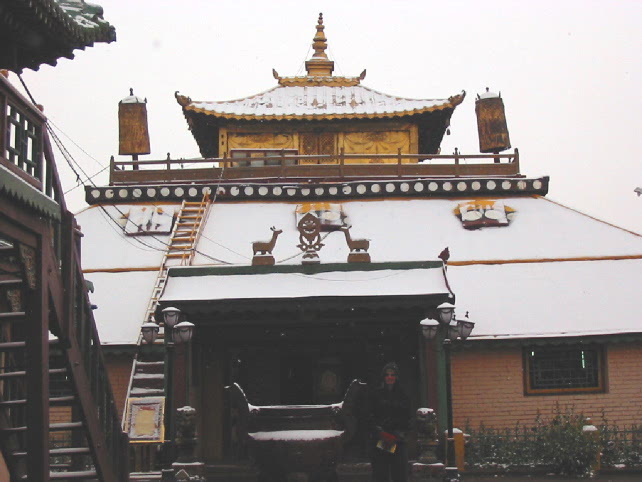 BACK to "Stories" list
BACK to "Stories" list
 BACK to "Stories" list
BACK to "Stories" list
 to Russia and Mongolia Photo Album
to Russia and Mongolia Photo Album
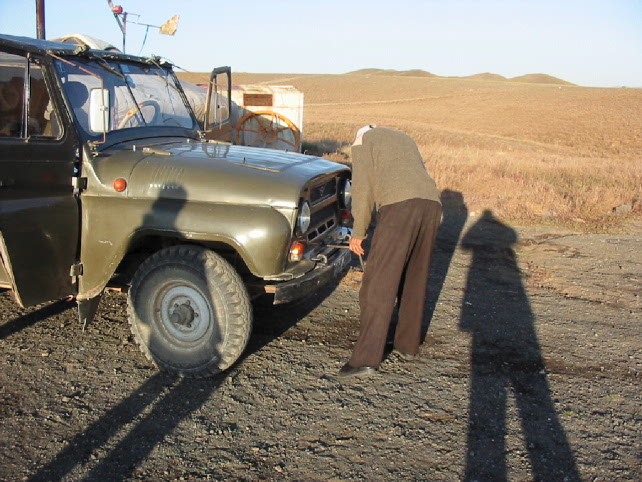
For larger images click on the photos. |
Our side trip to Mongolia started out as an afterthought. Like the Trans-Siberian Railway,
it had to do with one of Louie's fascinations. As a child she became captivated by the story
of Roy Chapman Andrews, who had discovered the first dinosaur eggs in the Gobi Desert of
Mongolia. So much so, she read the book over and over, until it disappeared from the local
library. She hadn't thought about it much until she came across a reference to it while doing
research for the train trip. So, from Irkutsk, we flew on an ancient Russian airplane to Ulaanbaatar, the capital of Mongolia. The plane was a little rickety looking but the service was fine. We liked U.B. (no visitor likes to spell or pronounce it), it's a great beer town. See Mongolian Beer for more on that. The flight to Dalanzadgad was on a similar plane. Upon arrival we were met by Baatuul, our pretty female guide, and Ulmaa our stoic but nice male driver. The mode of transport was an equally old Russian jeep. (The great thing about the jeep was that it had a starter crank, just like the ones you see in silent movies. And we actually had to use it one morning when the jeep wouldn't start.) It being late in the day we took a reasonably short ride to a national park, where we visited a museum stuffed with stuffed animals. Some were a little ratty but it was interesting to see how many different animals can live in a desert. We then spent our first night in a "ger," the typical nomadic circular hut of Mongolian herdsmen. The gers are truly portable made of a large roll of felt for the base, a many spoked support system for the ceiling and a canvas cover. Ghengis Khan called his horde "the people of the felt walls." |
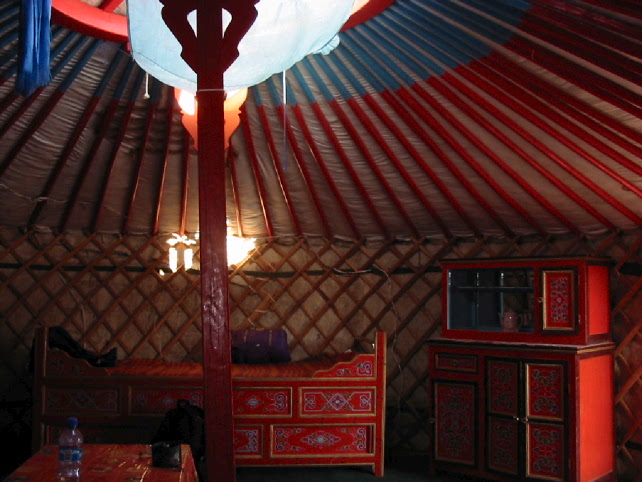
For larger images click on the photos. |
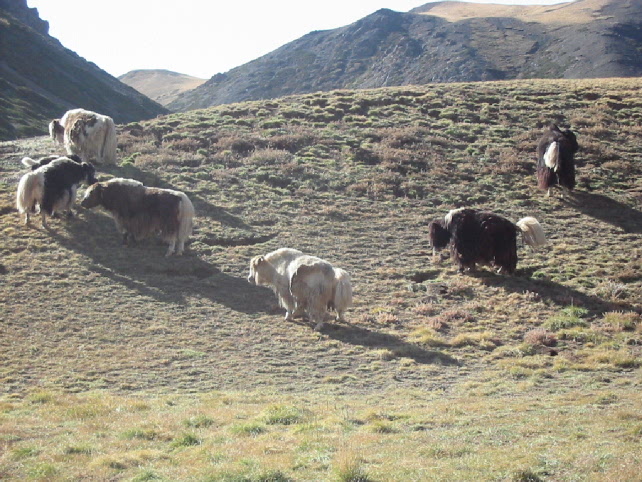
|
After a very nice breakfast prepared by Baatuul on her tiny propane stove, we were off to the
valley of the eagles, Khongoring Els. We spotted some high flying birds (vultures?),some wild ibex
and some wooly yaks -- cute aren't they? And some wild marmots, the Mongols hunt them as a
New Year's delicacy. |
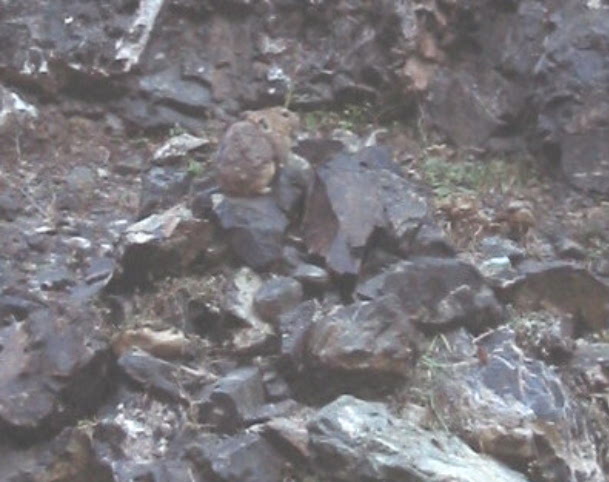
|

|
Our afternoon lunch was at another ger where Enkhjargal provided us with cheese curd, dried
yogurt and vodka made from goat milk whey. The nomadic people herd many different species of
animals: goats, sheep, cows, horses, camels, yaks and ,in the north, reindeer. Each Mongolian
family specializes in one or two types. Goats are the money crop because they are combed for
their fine wool. These people are true nomads, feeding their animals on the sparse tundra of
the Gobi. They move when required by the weather, some years every week. So it is impossible
to find them at any given time. As we scurried across the almost featureless land we would spot
a ger sitting by itself with it's animals scattered around. We stopped at different gers along
the way and each time were treated to excellent hospitality. We later learned that our hosts
received no payment and our guides had never met them before and might never see them again.
Our next attraction was the great sand dunes. The Gobi is a desert, but it has only one area
of sand dunes which stretch over one hundred kilometers. Louie and Baatuul insisted on climbing
the dunes, I was reluctant and waited part way up while Louie crawled to the top, for these photos. |
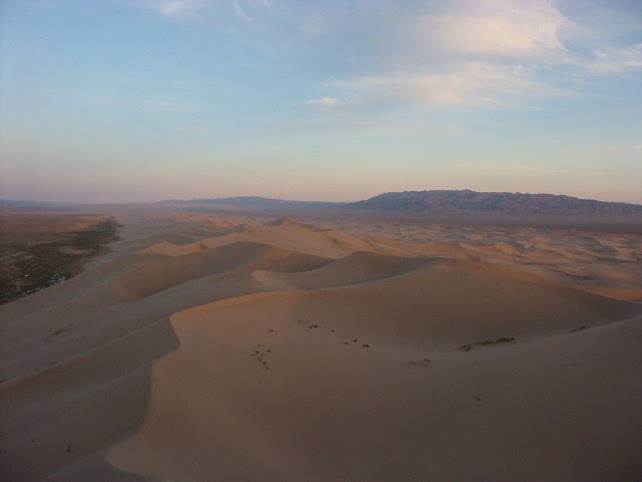
|

|
Each day was a little colder so when we got up for our mandatory camel ride the next morning, we
were dressed quite warmly. I really don't like riding animals, especially camels, but I will say
that the two humpers, batrick camels, are more comfortable than the one humpers that we rode in Egypt.
The nomads at our lunchtime ger stop entertained us by playing a Mongolian violin. On our way to
the Flaming Cliffs we stopped in the village were Baatuul had been born. Her mother was a doctor
and had been stationed there at the time. Baatuul asked if we had ever had hushuur. We said no.
So off we went to a small shop and she ordered two a piece for the four of us. They turned out
to be fried meat pies. Of course, when I asked what kind of meat they contained, the answer was
horse. It was very tasty. |
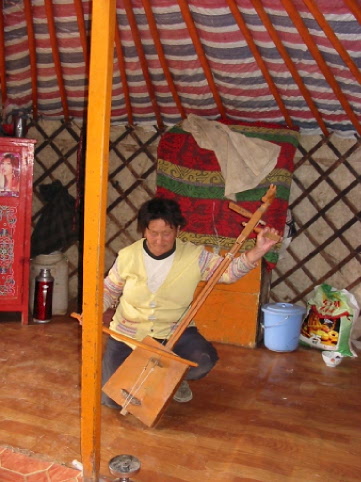
|
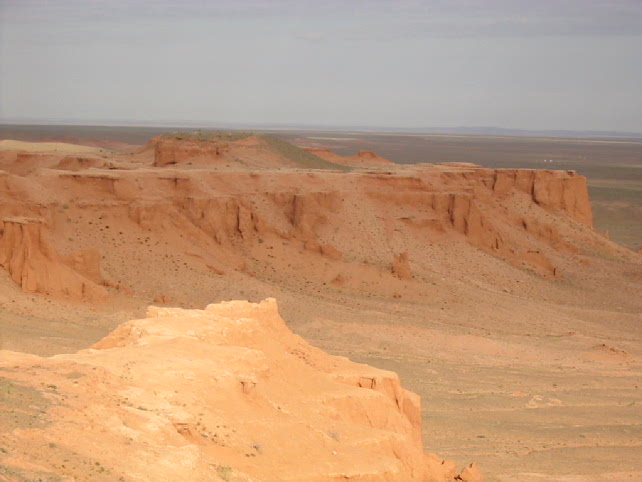
|
The Flaming Cliffs, as mentioned, are home to a major dinosaur site. The archeologists and locals
still find eggs and bones. The museum had several different shaped examples of the various
cluthes of eggs. It is illegal to take them out of Mongolia, but that didn't stop a vendor
from trying to sell us one. Could have been a ball of mud anyway. As you can see, the cliffs
are really pink, but the sun can make them glow. |
|
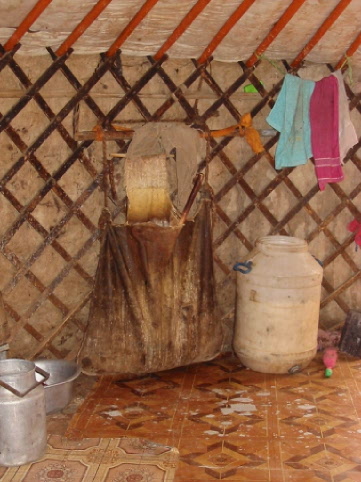
|
As we made our way toward the airport Baatuul and the driver seemed to be searching for something.
Finally we pulled up to a ger with a string of horses next to it. After Baatuul conferred with
the inhabitants she asked us, "Have you ever had fermented mares milk?" When we said, "no," she
of course offered to get us some. Inside the ger we saw a leather pouch which was the fermenter.
The lady of the house dipped us a bowl of foamy milk which definitely had an alcoholic twang to it.
Next we went outside to watch the milking. Each mare has a foal tethered to it, after having the
foal start the milk flowing the milkmaid draws a few ounces of milk and moves on to the next mare.
They do this a few times a day but only when the foals are mostly weaned. When I saw a little girl
dipping a rope into the bucket I was glad I had drunk some before I saw what she was doing. |
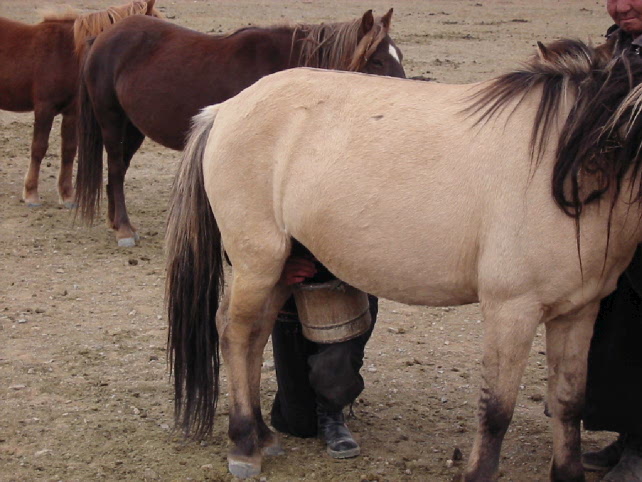
|
